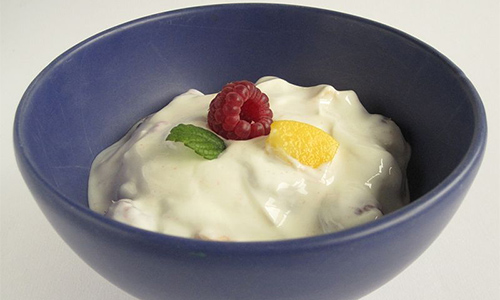
Yogurt is a semi fluid fermented milk food. The lactic acid content gives it a mildly sour taste. It is smooth and creamy.
Yogurt is made from the milk of cows, sheep, goats and water buffalo. In North America and Europe cow milk is used. Sheep and goats milk is used in southern and Eastern Europe.
Buffalo milk is the most popular for making yogurt in Egypt and India. In India yogurt is called curd or curds and dahi in Hindi. Curd in other parts of the world refers to a liquid that has been coagulated or curdled by adding renin or and acidic agent such as lime or vinegar. Yogurt used extensively in Indian cooking and the Indian child god Krishna is revered despite his penchant for helping himself freely to any pot of yogurt he could lay his hands on. Once a year, a festival that celebrates his birthday, attracts groups of young people participate in a competition. The objective of the competition is to bring down a pot of yogurt fixed at challenging height. The competing groups form human pyramids with the lightest member climbing to the top and attempting to smash the pot with a stick.
There are conflicting claims as to the origins of yogurt. It is commonly accepted that the technique of making yogurt originated in Turkey. It is made by boiling or pasteurising milk in an open pan, to let as much water as possible evaporate. Then it is cooled to a point that a fingertip can be dipped comfortable into the milk. It should be warm, not hot or cold, nor even cool. Once the temperature is gauged to be suitable the milk is injected with yogurt from a previous batch. It is then covered and left to stand in a warm place for approximately eight hours. In cold weather it may take up to twelve hours to set. Humidity also affects the setting time. When the yogurt is formed or set, it is kept in a cool place.
Greek yogurt is also called strained yogurt, yogurt cheese or labneh. It is an important ingredient of Greek cooking. The procedure for making Greek yogurt is essentially the same as regular yogurt. Greek yogurt should contain live, active culture, not just a starter culture, but this is not always the case.
It is made by straining the regular yogurt through a cloth like an old cotton T shirt. It is kept standing in the cloth for a few hours until the whey has completely drained out, leaving an exotic, thick semi solid that is far creamier and tangier, but less sweet than its simpler counterpart.
Greek yogurt is nutritionally far superior to yogurt. Marketing this information has catapulted Greek yogurt to the status of a super food.
Both forms of yogurt are packed with calcium and pro biotic bacteria. They are low on calories, making yogurt an ideal health food drink.
Much of the lactose sugar is drained away with the whey. This makes it easier for the lactose intolerant. At comparable calorie content, Greek yogurt contains double the protein and half the sugar.
A 6 oz. serving of Greek yogurt contains 15-20 grams of protein, equal to 9 oz. of yogurt. This is especially helpful for vegetarians, as their protein intake is often under the optimum requirement.
The carb content of yogurt is higher than that of Greek yogurt. Per serving the former has 13-17 grams compared to 5-8 grams in the latter.
Greek yogurt has a lower sodium content making it a healthier food.
Yogurt has more calcium and a six oz. serving provides 30% of the recommended daily calcium requirement, while a similar serving of Greek yogurt will give only 20%.
Mass consumption of Greek yogurt raises some environmental concerns. It takes 4 oz. of milk to make 1 oz. of Greek yogurt. Large institutions serving it are left with oceans of highly acidic whey that cannot be used productively.
Despite the differences and drawback, both yogurt and Greek yogurt are very nutritious foods and highly recommended especially when made at home.
Read more: The Differences Between Yogurt and Greek Yogurt – A Knowledge Archive http://infomory.com/health/differences-yogurt-greek-yogurt/#ixzz4MuPe2XAC





























